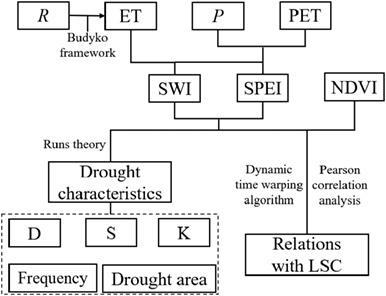当前位置:
X-MOL 学术
›
Int. J. Climatol.
›
论文详情
Our official English website, www.x-mol.net, welcomes your
feedback! (Note: you will need to create a separate account there.)
Spatio-temporal variability of dryness and wetness based on standardized precipitation evapotranspiration index and standardized wetness index and its relation to the normalized difference vegetation index
International Journal of Climatology ( IF 3.5 ) Pub Date : 2021-06-21 , DOI: 10.1002/joc.7266 Wenhan Lv 1 , Chuanhao Wu 2, 3 , Pat J.‐F. Yeh 4 , Bill X. Hu 2, 3
International Journal of Climatology ( IF 3.5 ) Pub Date : 2021-06-21 , DOI: 10.1002/joc.7266 Wenhan Lv 1 , Chuanhao Wu 2, 3 , Pat J.‐F. Yeh 4 , Bill X. Hu 2, 3
Affiliation

|
Land surface change (LSC) due to human-caused global environmental changes has considerably affected the development of regional droughts. The standardized wetness index (SWI) developed recently by combining the standardized precipitation evapotranspiration index (SPEI) with the evapotranspiration (ET) estimated from the Budyko framework considers the joint effects of climate variability and LSC on the land dryness/wetness conditions. Here, using a 25-year (1984–2008) monthly gridded terrestrial water budget dataset, a comparative global analysis of the spatio-temporal variability of drought characteristics (duration D, severity S, peak K, frequency, and drought area) estimated based on SWI and SPEI is presented. The relationship between dryness/wetness (as indicated by SWI and SPEI) and LSC (as indicated by the Normalized Difference Vegetation Index, NDVI) is explored by correlation analysis and the dynamic time warping algorithm (DTW). The results show that SWI is strongly correlated with SPEI for most global regions (except for the extremely arid and extremely humid regions). Both SWI and SPEI show similar directions and magnitudes in the trends of drought characteristics during 1984–2008. However, the drying trends in SPEI are stronger than that of SWI particularly in arid regions, accompanied with larger global drought areas and higher frequencies of extreme drought. Furthermore, the correlation between SWI and LSC is larger than that between SPEI and LSC particularly in arid regions (e.g., northern Africa, Indus, and southern Australia). As SWI accounts for the effects of LSC, it can be inferred that the underestimation of drying trend indicated by SWI relative to SPEI is partially caused by LSC.
中文翻译:

基于标准化降水蒸散指数和标准化湿度指数的干湿时空变化及其与标准化差异植被指数的关系
人为引起的全球环境变化引起的地表变化(LSC)极大地影响了区域干旱的发展。最近通过将标准化降水蒸散指数 (SPEI) 与从 Budyko 框架估计的蒸散量 (ET) 相结合而开发的标准化湿度指数 (SWI) 考虑了气候变率和 LSC 对土地干湿条件的联合影响。在这里,使用 25 年(1984-2008)每月网格化陆地水收支数据集,对干旱特征的时空变异性(持续时间D、严重程度S、峰值K,频率和干旱面积)基于 SWI 和 SPEI 估计。通过相关性分析和动态时间规整算法 (DTW) 探讨了干/湿(如 SWI 和 SPEI 所示)和 LSC(如归一化差异植被指数,NDVI 所示)之间的关系。结果表明,在全球大部分地区(极度干旱和极度潮湿地区除外),SWI与SPEI密切相关。SWI 和 SPEI 在 1984-2008 年间的干旱特征趋势中显示出相似的方向和幅度。然而,SPEI的干旱趋势明显强于SWI,特别是在干旱地区,伴随着更大的全球干旱区域和更高的极端干旱频率。此外,SWI 和 LSC 之间的相关性大于 SPEI 和 LSC 之间的相关性,特别是在干旱地区(例如,北非、印度河和澳大利亚南部)。由于 SWI 考虑了 LSC 的影响,因此可以推断 SWI 相对于 SPEI 对干燥趋势的低估部分是由 LSC 引起的。
更新日期:2021-06-21
中文翻译:

基于标准化降水蒸散指数和标准化湿度指数的干湿时空变化及其与标准化差异植被指数的关系
人为引起的全球环境变化引起的地表变化(LSC)极大地影响了区域干旱的发展。最近通过将标准化降水蒸散指数 (SPEI) 与从 Budyko 框架估计的蒸散量 (ET) 相结合而开发的标准化湿度指数 (SWI) 考虑了气候变率和 LSC 对土地干湿条件的联合影响。在这里,使用 25 年(1984-2008)每月网格化陆地水收支数据集,对干旱特征的时空变异性(持续时间D、严重程度S、峰值K,频率和干旱面积)基于 SWI 和 SPEI 估计。通过相关性分析和动态时间规整算法 (DTW) 探讨了干/湿(如 SWI 和 SPEI 所示)和 LSC(如归一化差异植被指数,NDVI 所示)之间的关系。结果表明,在全球大部分地区(极度干旱和极度潮湿地区除外),SWI与SPEI密切相关。SWI 和 SPEI 在 1984-2008 年间的干旱特征趋势中显示出相似的方向和幅度。然而,SPEI的干旱趋势明显强于SWI,特别是在干旱地区,伴随着更大的全球干旱区域和更高的极端干旱频率。此外,SWI 和 LSC 之间的相关性大于 SPEI 和 LSC 之间的相关性,特别是在干旱地区(例如,北非、印度河和澳大利亚南部)。由于 SWI 考虑了 LSC 的影响,因此可以推断 SWI 相对于 SPEI 对干燥趋势的低估部分是由 LSC 引起的。











































 京公网安备 11010802027423号
京公网安备 11010802027423号